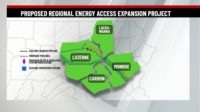Leading his final Federal Energy Regulatory Commission meeting on Dec. 15, Chairman Richard Glick now prepares to leave the agency as his term expires and Senate Energy and Natural Resources Committee chief Joe Manchin (D-W.Va.) refuses to hold a hearing by year-end to confirm his renomination by the White House.
Glick’s departure leaves the near-term agenda of the regulator of U.S. pipelines, natural gas facilities and more recently, transmission infrastructure, with some uncertainties. A former backwater, FERC has been in the spotlight of late as its handling of U.S. projects and policies drew attention in the developing energy transition and environmental movement, and pressure mounted for it to do more—or much less.
Replacing Glick may take months, although current Democratic Commissioner Allison Clements is a reputed strong contender; in the interim, FERC faces risks of 2-2 vote splits among its Democrat and Republican members on some controversial rulings ahead.
(Jan. 4 update: President Joe Biden named Commissioner Willie Phillips as acting FERC chairman, the White House said Jan. 3. Phillips was named to the agency last year for a term to expire on June 30, 2026. He will fill the role until a permanent successor to Richard Glick is confirmed by the US Senate,)
Under Glick, FERC sought to consider environmental justice issues when assessing community impacts of projects up for approvals.
It also has pushed a controversial measure to control their greenhouse gas emissions, including downstream, to fight climate change and to expedite power transmission projects to connect renewable energy sources.
The greenhouse gas monitoring proposal followed more aggressive legal challenges to projects from environmental advocate opponents and court rulings that agreed with them but it has been downgraded to "draft" status at this point.
Meanwhile, on Dec. 21, several groups including the Sierra Club and Natural Resources Defense Council filed a request that FERC rehear its November approval of the Commonwealth LNG export terminal project in Louisiana, which has moved forward since the Ukraine invasion and could have a final investment decision by mid-2023. The opponents are challenging FERC's assessment of the project's benefits and harms.
Glick, who joined FERC in the Trump administration, was named chairman by President Joe Biden last year. Gregory Wetstone, CEO of the American Council on Renewable Energy, called him “an exceptionally effective and visionary leader.”
But some FERC actions elevated partisan tensions among commissioners and upset developers and Republican lawmakers, as well as Manchin, who felt the agency failed to advance needed fossil fuel projects in the wake of the Ukraine situation and are concerned that its push under Glick for more long term national transmission planning to upgrade grids and boost clean energy connections will conflict with roles of state and local energy regulators.
Its greenhouse gas reporting proposed rule has since been downgraded to “draft” status.
Also unclear is how FERC will move forward on planned regulations related to new "backstop authority" granted it by the 2021 federal infrastructure act to approve high-voltage interstate transmission project permits in so-called “national corridors” deemed necessary by the US Energy Dept "even when such siting authority has been expressly rejected by a state agency," say Bracewell attorneys.
FERC is set shortly to seek comment for 90 days on its proposed rulemaking, which already has raised concerns of its Republican commissioners "about potential overreach," the attorneys note. "It remains to be seen whether and how quickly FERC will be able to move forward with a final rule ... and whether and how [the agency] ultimately will wield its backstop authority," they contend.
Also pushed by Glick at the last meeting for FERC's agenda is the potential of broadened and tightened transmission station and infrastructure security rules in the wake of the recent gunfire attack on a North Carolina facility that halted power to 45,000 for several days.
The agency is set for a fiscal 2023 funding boost in the omnibus budget package approved by Congress on Dec. 23—to $508.4 million, up from $466.4 million in the current year, including nearly $25 million more for staff related to public outreach in natural gas and power project approval.
The funding package also includes $46.5 billion to the US Energy Dept. in the next fiscal year, 4% more than the previous one. Its Office of Energy Efficiency and Renewable Energy is set to gain a record $3.46 billion allocation, up 6% from fiscal 2022, for research and development of clean vehicle technologies, renewable energy grid integration and clean hydrogen production. Billions more also were gained under the 2021 federal infrastructure law for DOE funding of advanced nuclear power and other clean energy demonstration projects.
The omnibus package also clears $30 million for DOE-funded oil and gas well cleanup work and $60 million for methane mitigation.
But there is no funding increase to boost electric grid transformer production, despite power sector industry groups' request for $1 billion, with growing labor and supply chain disruptions that have dramatically increased order times for what is a crucial power system component, says S&P Global.






Post a comment to this article
Report Abusive Comment